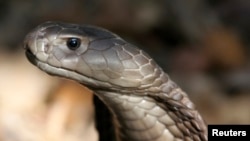The instantaneous sense of alarm you feel when encountering a snake may not be the result of pranks played by an older brother with a rubber snake or biblical depictions of snakes as evil characters. Instead, it might be an evolutionary trait that helped primates survive.
In fact, we may have snakes to thank for our high-quality vision, according to new research.
The research showed that there are specific nerve cells in the brains of rhesus macaque monkeys that respond to images of snakes.
The snake-sensitive neurons were more numerous, and responded more strongly and rapidly, than other nerve cells that fired in response to images of macaque faces or hands, or to geometric shapes. Lynne Isbell, a professor of anthropology at the University of California, Davis who led a team of researchers in the U.S., Japan and Brazil, said she was surprised that more neurons responded to snakes than to faces, given that primates are highly social animals.
"We're finding results consistent with the idea that snakes have exerted strong selective pressure on primates," she said.
Isbell first put forward the theory in 2006, arguing that our primate ancestors evolved good, close-range vision primarily to spot and avoid dangerous snakes.
Modern mammals and snakes big enough to eat them evolved at about the same time, 100 million years ago. Venomous snakes are thought to have appeared about 60 million years ago — "ambush predators" that have shared the trees and grasslands with primates.
The monkeys tested in the experiment were reared in a walled colony and neither had previously encountered a real snake.
"I don't see another way to explain the sensitivity of these neurons to snakes except through an evolutionary path," Isbell said.
The paper was published October 28 in the journal Proceedings of the National Academy of Sciences.
In fact, we may have snakes to thank for our high-quality vision, according to new research.
The research showed that there are specific nerve cells in the brains of rhesus macaque monkeys that respond to images of snakes.
The snake-sensitive neurons were more numerous, and responded more strongly and rapidly, than other nerve cells that fired in response to images of macaque faces or hands, or to geometric shapes. Lynne Isbell, a professor of anthropology at the University of California, Davis who led a team of researchers in the U.S., Japan and Brazil, said she was surprised that more neurons responded to snakes than to faces, given that primates are highly social animals.
"We're finding results consistent with the idea that snakes have exerted strong selective pressure on primates," she said.
Isbell first put forward the theory in 2006, arguing that our primate ancestors evolved good, close-range vision primarily to spot and avoid dangerous snakes.
Modern mammals and snakes big enough to eat them evolved at about the same time, 100 million years ago. Venomous snakes are thought to have appeared about 60 million years ago — "ambush predators" that have shared the trees and grasslands with primates.
The monkeys tested in the experiment were reared in a walled colony and neither had previously encountered a real snake.
"I don't see another way to explain the sensitivity of these neurons to snakes except through an evolutionary path," Isbell said.
The paper was published October 28 in the journal Proceedings of the National Academy of Sciences.











